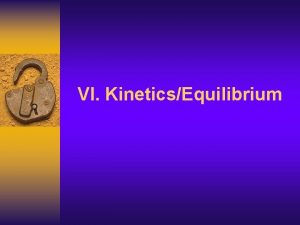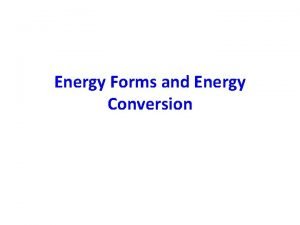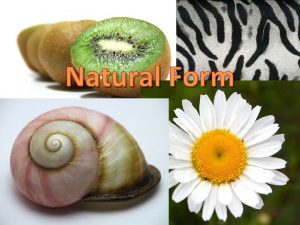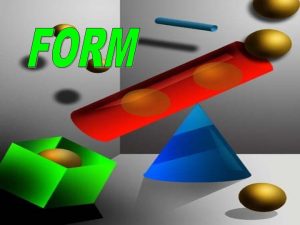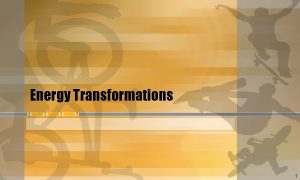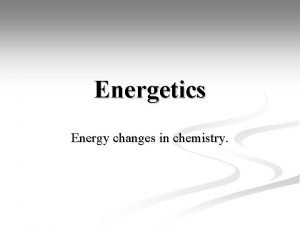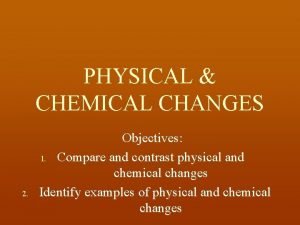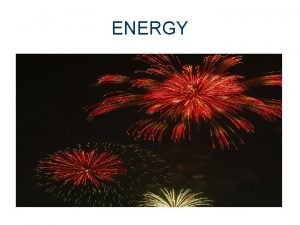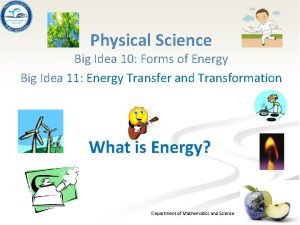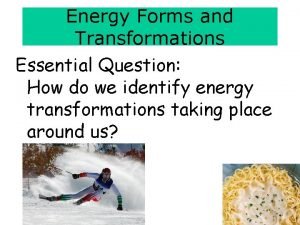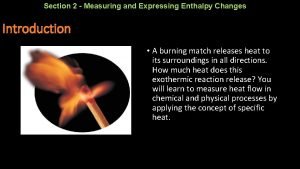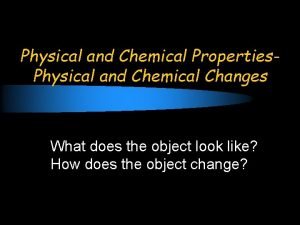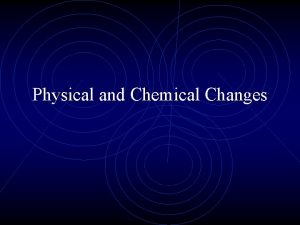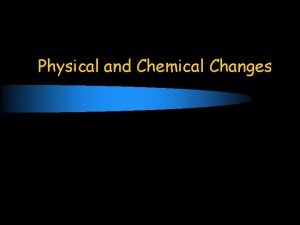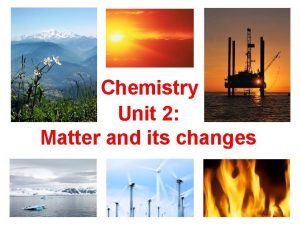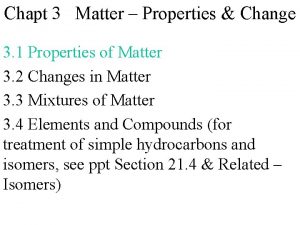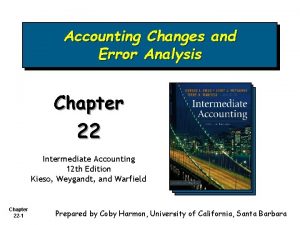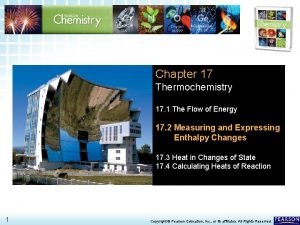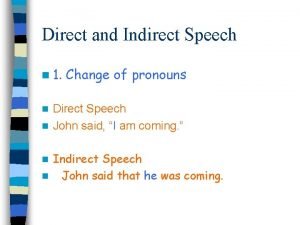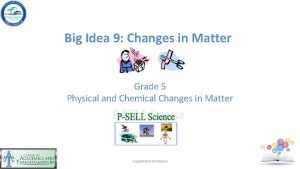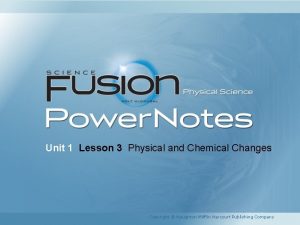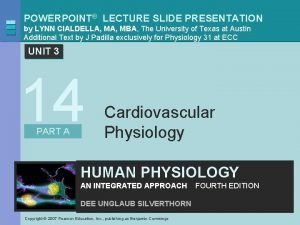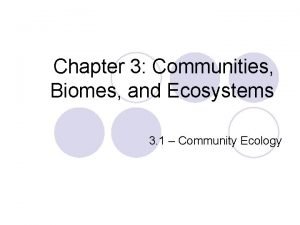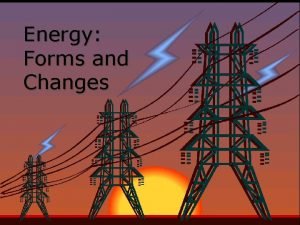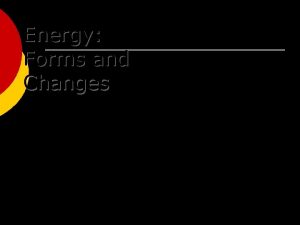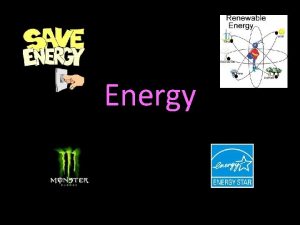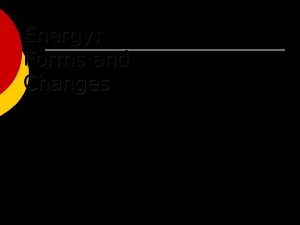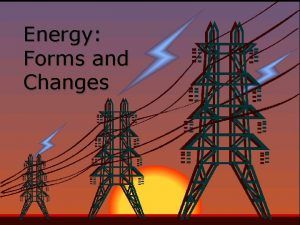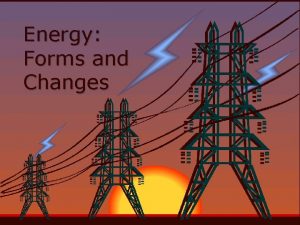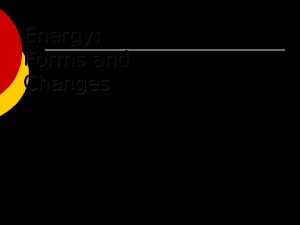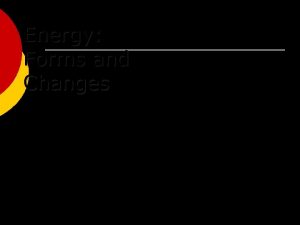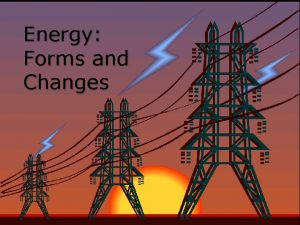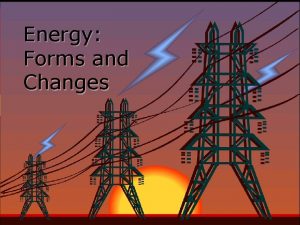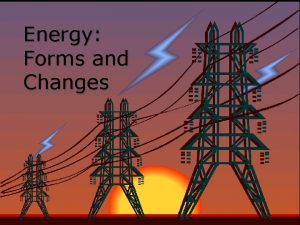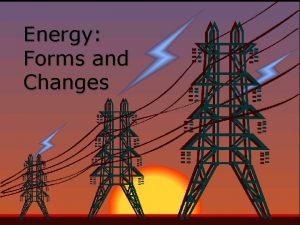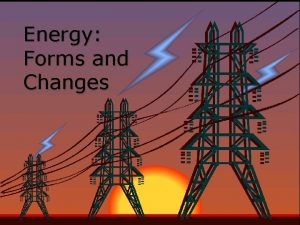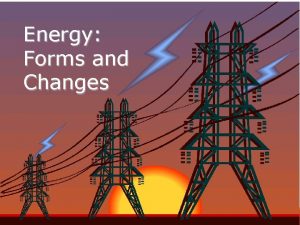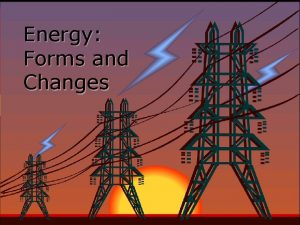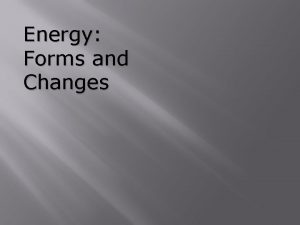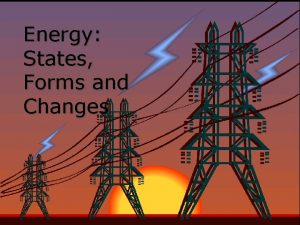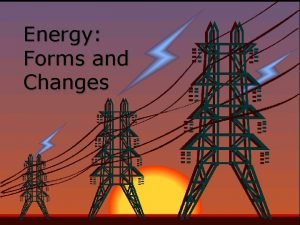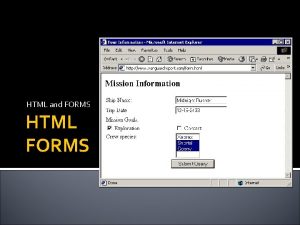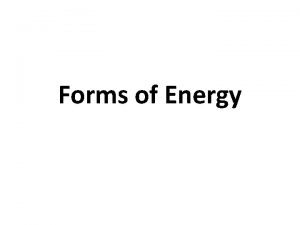Energy Forms and Changes Nature of Energy Energy


















































- Slides: 50

Energy: Forms and Changes

Nature of Energy ¡ Energy is all around you! You can hear energy as sound. l You can see energy as light. l And you can feel it as wind. l

Nature of Energy ¡ You use energy when you: l l l hit a softball. lift your book bag. compress a spring.

Nature of Energy Living organisms need energy for growth and movement.

Nature of Energy ¡ Energy is involved when: l l a bird flies. a bomb explodes. rain falls from the sky. electricity flows in a wire.

Nature of Energy ¡ Energy is used to do work ¡ Objects gain energy because work is being done on them. ¡ In order for work to be done an object must be moved. ¡ Work and energy are measured in units called joules

States of Energy The most common energy conversion is the conversion between potential and kinetic energy. ¡ All forms of energy can be in either of two states: ¡ l l Potential Kinetic

Kinetic Energy The energy of motion is called kinetic energy. ¡ The faster an object moves, the more kinetic energy it has. ¡ The greater the mass of a moving object, the more kinetic energy it has. ¡ Kinetic energy depends on both mass and velocity. ¡

States of Energy: Kinetic and Potential Energy ¡Kinetic Energy is the energy of motion. ¡Potential Energy is stored energy.

Kinetic Energy K. E. = mass x velocity 2 What has a greater affect of kinetic energy, mass or velocity? Why?

Potential Energy ¡ Potential Energy is stored energy. l l Stored chemically in fuel, the nucleus of atom, and in foods. Or stored because of the work done on it: Stretching a rubber band. ¡ Winding a watch. ¡ Pulling back on a bow’s arrow. ¡ Lifting a brick high in the air. ¡

End of Day One Assignment ¡ Fold Paper Hotdog Style ¡ Label one side Kinetic and one side Potential (Define each) ¡ Make a list of 10 sources of kinetic energy you see each day ¡ Make a list of 10 sources of potential energy you see each day. ¡

Gravitational Potential Energy ¡ Potential energy that is dependent on height is called gravitational potential energy.

Potential Energy ¡ Energy that is stored due to being stretched or compressed is called elastic potential energy.

Gravitational Potential Energy ¡ A waterfall, a suspension bridge, and a falling snowflake all have gravitational potential energy.

Gravitational Potential Energy ¡ If you stand on a 3 -meter diving board, you have 3 times the G. P. E, than you had on a 1 -meter diving board.

Gravitational Potential Energy “The bigger they are the harder they fall” is not just a saying. It’s true. Objects with more mass have greater G. P. E. ¡ The formula to find G. P. E. is G. P. E. = Weight X Height. ¡

Kinetic-Potential Energy Conversion Roller coasters work because of the energy that is built into the system. Initially, the cars are pulled mechanically up the tallest hill, giving them a great deal of potential energy. From that point, the conversion between potential and kinetic energy powers the cars throughout the entire ride.

Kinetic vs. Potential Energy At the point of maximum potential energy, the car has minimum kinetic energy.

Kinetic-Potential Energy Conversions ¡ As a basketball player throws the ball into the air, various energy conversions take place.

Ball slows down Ball speeds up

End of Day 2 Assignment/Lab ¡ Create a pendulum with a string and a weight ¡ Draw an outline of it on paper ¡ Identify the location with the greatest kinetic energy ¡ Identify the location/point with the greatest potential energy ¡

Day 3 ¡ Lab on ramps, marbles, and kinetic and potential energy

Forms of Energy ¡ The five main forms of energy are: Heat l Chemical l Electromagnetic l Nuclear l Mechanical l

Heat Energy The internal motion of the atoms is called heat energy, because moving particles produce heat. ¡ Heat energy can be produced by friction. ¡ Heat energy causes changes in temperature and phase of any form of matter. ¡

Chemical Energy ¡ Chemical Energy is required to bond atoms together. ¡ And when bonds are broken, energy is released.

Chemical Energy ¡ Fuel and food are forms of stored chemical energy.

Chemical Energy Fossil fuels are an example of chemical energy ¡ Fossil fuels include – coal, oil, and natural gas ¡ Fossil fuels are NONRENEWABLE and may eventually be used up. ¡ We are looking for alternative forms of energy ¡

Alternative Forms of Energy ¡ ¡ ¡ Solar – energy from the sun Geothermal – energy from the heat inside the earth Hydroelectric – energy created from water/dams Windmills – energy created from wind ALL OF THESE ARE INEXHAUSTIBLE RESOURCES – this means they can never be used up!!!!

Electromagnetic Energy ¡ Power lines carry electromagnetic energy into your home in the form of electricity.

Electromagnetic Energy ¡ ¡ ¡ Light is a form of electromagnetic energy. Each color of light (Roy G Bv) represents a different amount of electromagnetic energy. Electromagnetic Energy is also carried by X-rays, radio waves, and laser light.

Electromagnetic Energy/Electricity ¡ Sunlight can be transformed directly into electricity by the use of photovoltaic cells.

Nuclear Energy ¡ The nucleus of an atom is the source of nuclear energy.

Nuclear Energy When the nucleus splits (fission), nuclear energy is released in the form of heat energy and light energy. ¡ Nuclear energy is also released when nuclei collide at high speeds and join (fuse). ¡

Nuclear Energy The sun’s energy is produced from a nuclear fusion reaction in which hydrogen nuclei fuse to form helium nuclei.

Nuclear Energy ¡ Nuclear energy is the most concentrated form of energy. Most of us live within 10 miles of the Surry Nuclear Power Plant which converts nuclear energy into electromagnetic energy.

Mechanical Energy ¡ When work is done to an object, it acquires energy. The energy it acquires is known as mechanical energy.

Mechanical Energy ¡ When you kick a football, you give mechanical energy to the football to make it move.

Mechanical Energy When you throw a balling ball, you give it energy. When that bowling ball hits the pins, some of the energy is transferred to the pins (transfer of momentum).

End of Day 4 Homework ¡ Worksheet on identifying types of energy being used ¡

Energy Conversion ¡ Energy can be changed from one form to another. Changes in the form of energy are called energy conversions.

Law of Conservation of Matter States : Energy can neither be created nor destroyed, it changes form ¡ Another word for changing form is conversion ¡

Energy conversions ¡ All forms of energy can be converted into other forms. l l The sun’s energy through solar cells can be converted directly into electricity. Green plants convert the sun’s energy (electromagnetic) into starches and sugars (chemical energy).

Other energy conversions l l l In an electric motor, electromagnetic energy is converted to mechanical energy. In a battery, chemical energy is converted into electromagnetic/electric energy. The mechanical energy of a waterfall is converted to electrical energy in a generator.

Energy Conversions ¡ In an automobile engine, fuel is burned to convert chemical energy into heat energy. The heat energy is then changed into mechanical energy.

Chemical Heat Mechanical

Energy Chains Can be created from energy transferring from one form to another ¡ Example: Burning of coal Chemical Heat Light ¡

End of Lesson – Day 5 ¡ Homework – create 3 energy chains with 3 or more conversions of energy

Review on Energy ¡ Worksheet/Study Guide

Vocabulary Words energy mechanical energy heat energy chemical energy electromagnetic energy nuclear energy kinetic energy potential energy gravitational potential energy conversion Law of Conservation of Energy
 Changes in latitudes, changes in attitudes meaning
Changes in latitudes, changes in attitudes meaning Example of a chemical change
Example of a chemical change Systems in nature tend to undergo changes toward
Systems in nature tend to undergo changes toward Nature and nature's laws lay hid in night meaning
Nature and nature's laws lay hid in night meaning I had contracted form
I had contracted form Weak and strong forms
Weak and strong forms Eroei
Eroei Nature nature controversy
Nature nature controversy What is natural forms
What is natural forms Why are related forms more agreeable than unrelated forms?
Why are related forms more agreeable than unrelated forms? Why are related forms more agreeable than unrelated forms
Why are related forms more agreeable than unrelated forms Why are related forms more agreeable than unrelated forms?
Why are related forms more agreeable than unrelated forms? Enthalpy definition
Enthalpy definition Energy changing form
Energy changing form Energy changes
Energy changes What is thermochemistry
What is thermochemistry Compare and contrast chemical and physical changes
Compare and contrast chemical and physical changes Marriages and families changes choices and constraints
Marriages and families changes choices and constraints Marriages and families changes choices and constraints
Marriages and families changes choices and constraints Forms of energy and their meaning
Forms of energy and their meaning Forms of energy
Forms of energy 100 examples of energy transformation
100 examples of energy transformation Energy energy transfer and general energy analysis
Energy energy transfer and general energy analysis Energy energy transfer and general energy analysis
Energy energy transfer and general energy analysis Measuring and expressing enthalpy changes
Measuring and expressing enthalpy changes Properties and changes of matter worksheet
Properties and changes of matter worksheet Physical and chemical changes
Physical and chemical changes Physical and chemical changes
Physical and chemical changes Physical and chemical changes
Physical and chemical changes Generation genius physical and chemical changes
Generation genius physical and chemical changes Physical and chemical changes
Physical and chemical changes Physical change
Physical change Differences between chemical and physical changes
Differences between chemical and physical changes Chemistry matter and its changes
Chemistry matter and its changes Matter-properties and changes answer key
Matter-properties and changes answer key Counterbalancing example
Counterbalancing example 17.2 measuring and expressing enthalpy changes answers
17.2 measuring and expressing enthalpy changes answers Which is true about chemical change
Which is true about chemical change Planning for choices and changes
Planning for choices and changes Whats chemical change
Whats chemical change Physical and chemical changes jeopardy
Physical and chemical changes jeopardy When does a physical change occur study jams
When does a physical change occur study jams Changing from direct to indirect speech
Changing from direct to indirect speech Chemical properties and changes lesson 4
Chemical properties and changes lesson 4 Physical change examples
Physical change examples Changes in matter grade 5
Changes in matter grade 5 Lesson 3 physical and chemical changes answers
Lesson 3 physical and chemical changes answers Pressure and volume changes during cardiac cycle ppt
Pressure and volume changes during cardiac cycle ppt Eating food physical or chemical change
Eating food physical or chemical change The science duo physical and chemical changes
The science duo physical and chemical changes Three biotic factors
Three biotic factors


